ctg96135
- 格式:pdf
- 大小:493.87 KB
- 文档页数:14
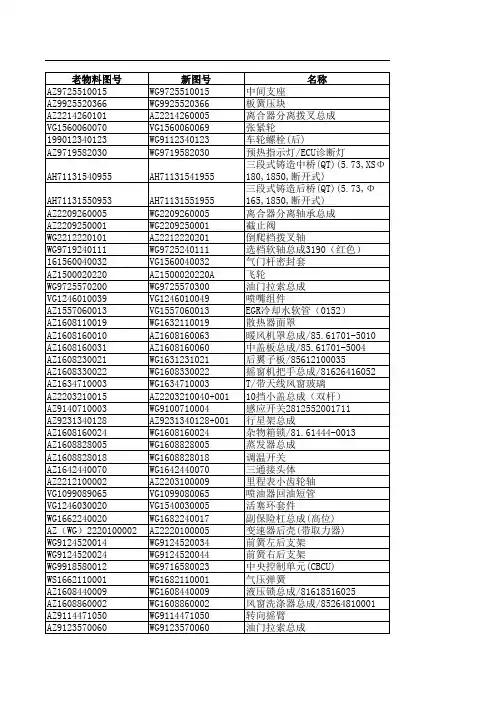
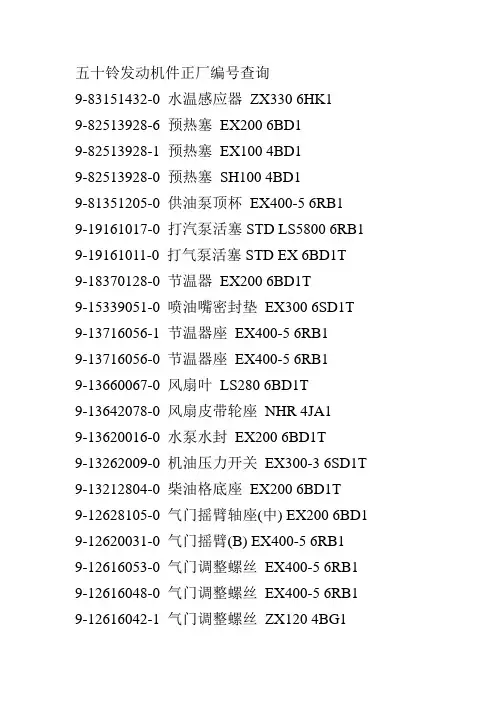
五十铃发动机件正厂编号查询9-83151432-0 水温感应器ZX330 6HK19-82513928-6 预热塞EX200 6BD19-82513928-1 预热塞EX100 4BD19-82513928-0 预热塞SH100 4BD19-81351205-0 供油泵顶杯EX400-5 6RB19-19161017-0 打汽泵活塞STD LS5800 6RB1 9-19161011-0 打气泵活塞STD EX 6BD1T9-18370128-0 节温器EX200 6BD1T9-15339051-0 喷油嘴密封垫EX300 6SD1T 9-13716056-1 节温器座EX400-5 6RB19-13716056-0 节温器座EX400-5 6RB19-13660067-0 风扇叶LS280 6BD1T9-13642078-0 风扇皮带轮座NHR 4JA19-13620016-0 水泵水封EX200 6BD1T9-13262009-0 机油压力开关EX300-3 6SD1T 9-13212804-0 柴油格底座EX200 6BD1T9-12628105-0 气门摇臂轴座(中) EX200 6BD1 9-12620031-0 气门摇臂(B) EX400-5 6RB19-12616053-0 气门调整螺丝EX400-5 6RB1 9-12616048-0 气门调整螺丝EX400-5 6RB1 9-12616042-1 气门调整螺丝ZX120 4BG19-12616042-0 气门调整螺丝EX200 6BD1 9-12613620-0 气门摇臂EX200 6BD1T9-12611448-2 气门摇臂(B) EX400-5 6RB1 9-12611448-0 气门摇臂(B) EX400-5 6RB1 9-12611446-2 气门摇臂(A) EX400-5 6RB1 9-12611446-0 气门摇臂(A) EX400-5 6RB1 9-12571113-0 气门挺杆EX200 6BD1T9-12569055-0 气门油封EX300 6SD1T9-12569037-0 气门油封EX300 6SD1T9-12563231-0 气门座EX300 6SD1T9-12561141-0 气门弹簧(大) EX400-5 6RB1 9-12531030-1 过桥齿座EX100 4BD19-12531030-0 过桥齿座EX200-5 6BG19-12531024-1 过桥齿套SK60 4JB19-12524805-0 高压泵齿SK60 4JB19-12523080-0 过桥齿SK60 4JB19-12521045-2 曲轴齿EX400-5 6RB19-12521043-0 曲轴齿EX100 4BD19-12514803-1 偏心轴EX200 6BD1T9-12514803-0 偏心轴EX200 6BD1T9-12379061-0 曲轴皮带轮套EX400-5 6RB1 9-12379045-0 曲轴皮带轮套EX200 6BD19-12378039-0 曲轴螺帽EX400-5 6RB19-12361024-2 曲轴前座圈EX400-5 6RB1 9-12361024-0 曲轴前座圈EX400-5 6RB1 9-12333607-0 飞轮齿环EX200 6BD1T9-12275608-0 连杆瓦+0.75 EX200 6BD19-12274608-0 连杆瓦+0.50 EX200 6BD19-12273608-4 连杆瓦+0.75 EX200 6BD1T 9-12273608-2 连杆瓦+0.25 EX200 6BD1T 9-12273608-0 连杆瓦+0.25 EX200 6BD19-12271608-1 连杆瓦STD EX200 6BD1T 9-12271608-0 连杆瓦STD EX200 6BD19-12211604-1 活塞肖EX200 6BD19-12211604-0 活塞肖EX200 6BD19-11751038-1 加机油口盖EX200-5 6BG1T 9-11693048-0 偏心轴瓦EX200 6BD1T9-11693035-0 偏心轴瓦EX200 6BD19-11691048-0 偏心轴瓦EX200 6BD19-11681015-0 偏心轴止推片ZX120 4BG1 9-11613035-0 偏心轴瓦SH220 6BG1T9-11611048-0 偏心轴瓦EX200 6BD19-11530606-0 曲轴瓦+0.25 EX200 6BD1T 9-11224602-1 机油泵齿芯EX200-3 6BG19-11224602-0 机油泵齿芯EX200-3 6BG1 9-09924512-0 曲轴后油封EX200-5 6BG1T 9-09924469-0 曲轴后油封EX200-5 6BG1T 9-09844190-0 偏心轴座螺母EX300 6SD1T 9-09840316-0 连杆螺帽EX400-5 6RB19-09840309-0 气门调整螺帽EX400-5 6RB1 9-09840107-1 曲轴螺母EX200 6BD19-09840107-0 曲轴螺母EX200 6BD1T9-09802629-0 曲轴座SK60 4JB19-09802606-0 曲轴螺丝SK60 4JB1。
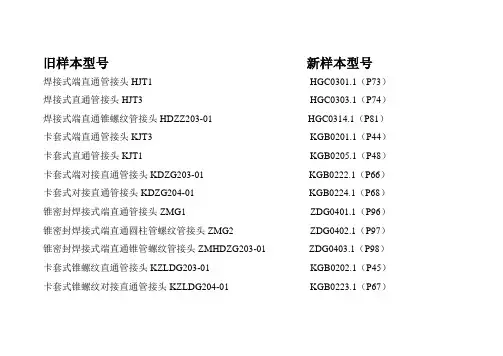
旧样本型号新样本型号焊接式端直通管接头HJT1 HGC0301.1(P73)焊接式直通管接头HJT3 HGC0303.1(P74)焊接式端直通锥螺纹管接头HDZZ203-01 HGC0314.1(P81)卡套式端直通管接头KJT3 KGB0201.1(P44)卡套式直通管接头KJT1 KGB0205.1(P48)卡套式端对接直通管接头KDZG203-01 KGB0222.1(P66)卡套式对接直通管接头KDZG204-01 KGB0224.1(P68)锥密封焊接式端直通管接头ZMG1 ZDG0401.1(P96)锥密封焊接式端直通圆柱管螺纹管接头ZMG2 ZDG0402.1(P97)锥密封焊接式端直通锥管螺纹管接头ZMHDZG203-01 ZDG0403.1(P98)卡套式锥螺纹直通管接头KZLDG203-01 KGB0202.1(P45)卡套式锥螺纹对接直通管接头KZLDG204-01 KGB0223.1(P67)扩口式端直通管接头KDTJT204-01 KGA0101.1(P18)扩口式锥螺纹直通管接头KZLWGJ204-01 KGA0102.1(P19)铜管用管接头GJT639 RGF0603.1(P126)铜管用直通管接头TJT634 RGF0607.1(P127)铜管用直角管接头JJT635 RGF0605.1(P127)钢管用螺纹连接三通接头ST8.5.4 ST8.5.4(P305)钢管用螺纹连接异径三通接头YST8.5.5 YST8.5.5(P305)钢管用螺纹连接弯头WT8.5.6 WT8.5.6(P306)钢管用螺纹连接外接头WT8.5.7 WT8.5.7(P306)钢管用螺纹连接内接头NJT8.5.8 NJT8.5.8(P307)钢管用螺纹连接内外接头NWJT8.5.9 NWJT8.5.9(P307)钢管用螺纹连接分管接头体FJT8.5.12 FJT8.5.12(P310)钢管用螺纹连接活接头HJT638 HJT638(P310)钢管用插入焊接式45°接头JT8.5.13 CGE0510.1(P120)钢管用插入焊接式变径接头BJT8.5.31 CGE0511.1(P121)钢管用插入焊接式接头JT8.5钢管用插入焊接式三通RST8.5.36 CGE0509.1(P120)钢管用插入焊接式弯头RWT8.5.37 CGE0501.1(P113)钢管用插入焊接式直通接头ZJT8.5.58 CGE0506.1(P118)钢管用插入焊接式变径直通接头BZT8.5.59 CGE0507.1(P118)钢管用插入焊接式变径接头RBJT8.5.61 CGE0505.1(P116)钢管用插入焊接式活接头RHT633 CGE0512.1(P121)钢管用插入焊接式高压法兰GFL631 CGE0513.1(P122)钢管用插入焊接式终端法兰ZFL826 CGE0514.1(P122)焊接式管接头SJT825 HGC0315.1(P82)焊接式管接头SJT8.27 HGC0322.1-1(P88)焊接式管接头SJT8.28 HGC0322.1-2(P88)带阀单向阀接头DFT636 DFT636(P317)带阀双向逆止阀接头SFT643 SFT643(P317)高压胶管总成GJG642 PGJ1201.1(P152)等径直角螺纹接头DJJT8.5.56 DJJT8.5.56 (P 313)等径直角螺纹长接头DCJT8.5.57 DCJT8.5.57 (P 313) 双通衬板SB8.5.64 SB8.5.64(P 314)直角法兰TFL8.5.65 TFL8.5.65(P 314)螺塞ZLS203 LGM2001.1(P 257) 旋转接头XJT637 XJT637(P318)分配器罩DWQZ828分配器罩DVQZ829分配器支架QJ8.5.47 QJ8.5.47 (P315)支架ZJ8.5.48 ZJ8.5.48 (P316)支架QJ8.5.43 QJ8.5.43(P316)管夹和管托架GJ811.1、GJ811.2、GJ811.3、GJ811.4 DGJ2201.1、D GJ2201.2、DGJ2201.3、DGJ2201.4(P269) U型螺栓US820 UXG2801.1 (P325)JG-焊接头、JGM-焊接头,带螺母ZTK1101.1焊接头、ZTK1101.2焊接头,带螺母(P148) DZT-端直通接头LGT2801.1 (P325)DZTN/DZTV-端直通管接头(公制螺纹、UNF螺纹)LGT2803.1(P327)BDT-变径端直通接头BDZ-变径端直通接头LGT2802.1 (P326)KDT-可调式端直通接头LGT2807.1(P331)KETM/KETA可调式端直通接头LGT2827.1(P349)KDZ-可调式端直角接头ZGD0416.1(P108)KZ-可调式端直角接头LGT2820.1(P343)STQ-三通管接头LGT2821.1(P344)ZTH-直通焊接接头ZGD0409.1(P103)ZTG-直通管接头ZGD0404.1(P99)ZJG-直角管接头ZGD0410.1(P103)STG-三通管接头ZGD0411.1(P104)FTG-四通管接头ZGD0419.1(P111)ZGB-直通隔壁管接头ZGD0413.1(P105)ZJGB-直角隔壁管接头ZGD0412.1(P105)ZJ-焊接头、DJ-焊接头,带螺母ZTK1103.1、ZTK1104.1(P150) JJT-铰接式接头LGT2817.1(P341)JST-铰接式三通管接头ZGD0418.1(P110)BJT-变径接头体BJT-变径接头体DT-堵头管路测试点接头KSE、HSC CGY2754.1、CGY2755.1(P297) FL-法兰FL(P211)FLJ-法兰接头FLJ(P211)FLM-盲孔法兰接头FLM(P211)FLJ/FLK-法兰接头-PN10-64(bar)FLJ/FLK(P212)FLJ/FLK-法兰接头-PN160(bar)FLJ/FLK(P213)FLJ/FLK-法兰接头-PN250(bar)FLJ/FLK(P214)FLJ/FLK-法兰接头-PN315(bar)FLJ/FLK(P215)FLJ/FLK-法兰接头-PN400(bar)FLJ/FLK(P216)FLJ/FLK-法兰接头-PN500(bar)FLJ/FLK(P217)BHG-变径焊接管BHG(P201)SF-三通法兰接头SF(P218)ZFL-直角法兰接头ZFL(P219)AFLJ/AFLK法兰接头AFLJ/AFLK(P220) DKF-对开法兰DKF(P221)QFL-全法兰QFL(P221)AFLJ-法兰接头AFLJ(P221)AFLK-法兰接头AFLK(P221)AFLM-盲孔法兰接头AFLM(P221)AFKM-盲孔法兰接头AFKM(P222)AFLJ/AFLK法兰接头(BSP内螺纹连接)AFLJ/AFLK(P223)FLA/FL-FLJX焊接法兰接头FLA/FL-FLJX(P224) SAFA/SAF-FLJX焊接法兰接头SAFA/SAF-FLJX(P225) SAFA/SAF-FLJX焊接法兰接头SAFA/SAF-FLJX(P226) BHM-24°锥FLJX法兰接头BHM-24°锥FLJX(P227)BHM-FLJX直角焊接法兰接头BHM-FLJX(P228)BHMW -24°锥FLJX直角法兰BHMW -24°锥FLJX(P229) BHMW -24°锥FLJX直角对开法兰接头BHMW -24°锥FLJX(P230) STF-FLJX三通法兰接头STF-FLJX(P231)旋转接头总成(P232)DJL-旋转接头DJL(P233)XJT/XZT-旋转接头XJT/XZT(P234)EFT-旋转接头EFT(P235)EDA-旋转接头EDA(P236)EDN-旋转接头EDN(P237)END-旋转接头END(P238)EDJ-旋转接头EDJ(P239)EDQO/EDA旋转接头EDQO/EDA(P240)WT-弯头GWJ1601.1(P197)腰形法兰接头-YFJT(3000Psi)YFJT(3000Psi)(P241) 腰形法兰接头-YFJT(6000Psi)YFJT(6000Psi)(P242) 腰形法兰接头-YFJ(3000Psi)YFJ(3000Psi)(P243) 腰形法兰接头-YFJ(6000Psi)YFJ(6000Psi)(P244) 方形法兰接头-FFJ FFJ(P245)方形法兰接头-FFJ FFJ(P246)快速接头-HRS1系列HRS1(P283)快速接头-HRS2系列HRS2(P286)快速接头-HRS3系列HRS3(P289)快速接头-HRS4系列HRS4(P292)轻型管夹(P270- P273)轻型叠加式管夹(P274)重型管夹(P275- P278) 重型叠加式管夹(P279)双联管夹(P280)。
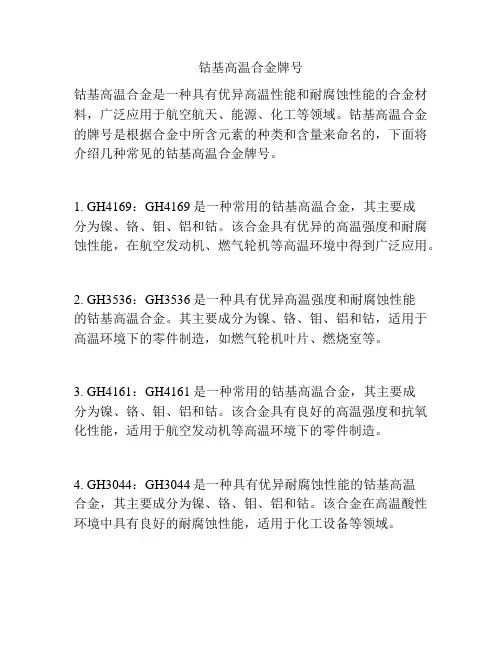
钴基高温合金牌号钴基高温合金是一种具有优异高温性能和耐腐蚀性能的合金材料,广泛应用于航空航天、能源、化工等领域。
钴基高温合金的牌号是根据合金中所含元素的种类和含量来命名的,下面将介绍几种常见的钴基高温合金牌号。
1. GH4169:GH4169是一种常用的钴基高温合金,其主要成分为镍、铬、钼、铝和钴。
该合金具有优异的高温强度和耐腐蚀性能,在航空发动机、燃气轮机等高温环境中得到广泛应用。
2. GH3536:GH3536是一种具有优异高温强度和耐腐蚀性能的钴基高温合金。
其主要成分为镍、铬、钼、铝和钴,适用于高温环境下的零件制造,如燃气轮机叶片、燃烧室等。
3. GH4161:GH4161是一种常用的钴基高温合金,其主要成分为镍、铬、钼、铝和钴。
该合金具有良好的高温强度和抗氧化性能,适用于航空发动机等高温环境下的零件制造。
4. GH3044:GH3044是一种具有优异耐腐蚀性能的钴基高温合金,其主要成分为镍、铬、钼、铝和钴。
该合金在高温酸性环境中具有良好的耐腐蚀性能,适用于化工设备等领域。
5. GH2132:GH2132是一种具有良好高温强度和耐腐蚀性能的钴基高温合金,其主要成分为镍、铬、钼、铝和钴。
该合金适用于高温环境下的零件制造,如航空发动机叶片、燃气轮机叶片等。
6. GH4169LC:GH4169LC是一种具有优异高温强度和耐腐蚀性能的钴基高温合金,其主要成分为镍、铬、钼、铝和钴。
该合金适用于航空发动机等高温环境下的零件制造。
7. GH3535:GH3535是一种具有良好高温强度和耐腐蚀性能的钴基高温合金,其主要成分为镍、铬、钼、铝和钴。
该合金适用于高温环境下的零件制造,如燃气轮机叶片等。
8. GH4033:GH4033是一种具有优异耐腐蚀性能的钴基高温合金,其主要成分为镍、铬、钼、铝和钴。
该合金在高温酸性环境中具有良好的耐腐蚀性能,适用于化工设备等领域。
以上是几种常见的钴基高温合金牌号,它们在不同领域具有广泛的应用。
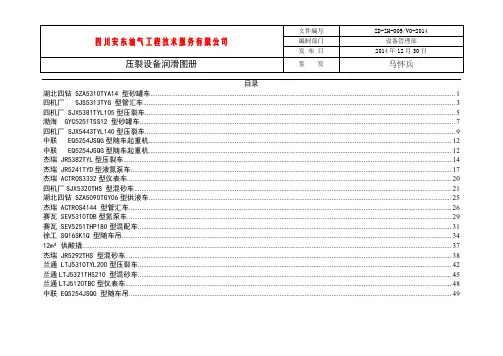
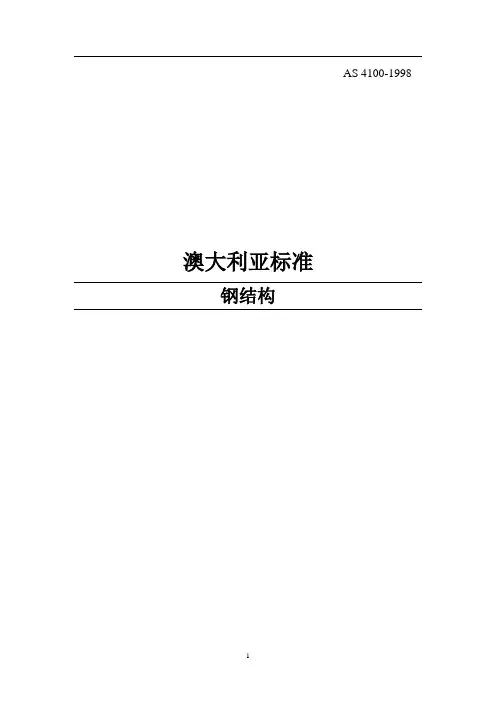
AS 4100-1998澳大利亚标准钢结构前言本标准是澳大利亚标准委员会“BD/1,钢结构”为了替代AS 4100—1990而编写的。
本标准的目标是向钢结构设计者提供有关建筑物和其他结构中的钢结构构件(用于承载目的)的规范。
本标准的这一新版本中包括:修正案1号——1992,2号——1993,3号——1995和修订版草案4号(出于公众评论目的而发行)DR 97437。
修订班草案4号并没有作为一个通用文件而单独出版发行。
修正案1号—1992包含下列主要变更:(a)钢材强度符合AS 1163和AS/NZS 1594的要求(表2.1)(b)加强腹板的抗剪弯曲载量(5.11.5.2部分)(c)承载弯曲载量(5.13.4部分)修正案2号—1993包含下列主要变更:(a)弯曲和剪力交互作用的方法(5.12.3部分)(b)中间部分横向腹板加强构件的设计最小面积(5.15.3部分)(c)构件承受组合作用的剖面载量(8.3部分)(d)对接焊缝的强度评估(9.7.2.7部分)(e)疲劳(11部分)修正案3号—1993包含下列主要变更:(a)腹板边缘的抗压承载作用(5.13部分)(b)构件承受组合作用的剖面载量(8.3部分)(c)抗压构件的平面内、外载量(8.4.2.2部分和8.4.41部分)(d)对接焊缝的强度评估(9.7.2.7部分)(e)地震(13部分)修正案4号包含下列主要变更:(a)钢材强度符合AS/NZS 3678、AS/NZS 3679.1和AS/NZS 3679.2的要求(表2.1)(b)紧固件的最小边缘距离(9.6.2部分)(c)容许使用温度,根据钢材类型和厚度(表10.4.1)(d)钢材类型和钢材等级之间的关系(表10.4.4)(e)同心支撑框架的焊接,用于处在地震设计D类和E类作用下的结构(13.3.4.2部分)本标准使用了“标准”和“提供信息用”这两个术语以对附录的适用范围几逆行能够详细说明。
“标准”附录是标准的一个主要组成部分,而“提供信息用”则仅仅是用来提供信息和指导性意见的。
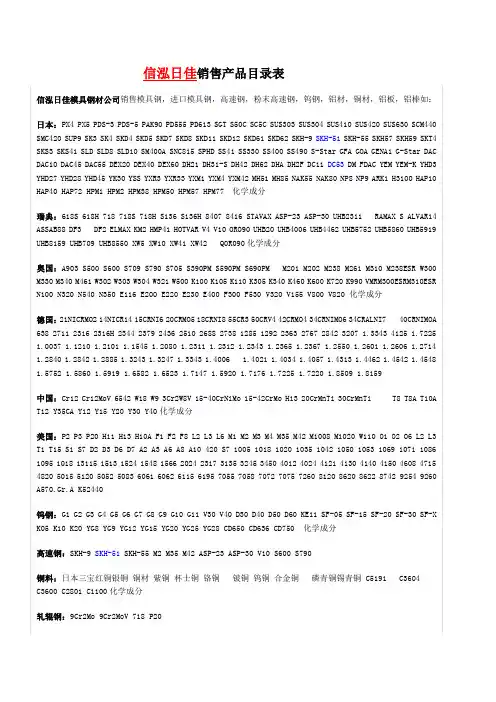
信泓日佳销售产品目录表信泓日佳模具钢材公司销售模具钢,进口模具钢,高速钢,粉末高速钢,钨钢,铝材,铜材,铝板,铝棒如:日本:PX4 PX5 PDS-3 PDS-5 PAK90 PD555 PD613 SGT S50C SC5C SUS303 SUS304 SUS410 SUS420 SUS630 SCM440 SMC420 SUP9 SK3 SK4 SKD4 SKD5 SKD7 SKD8 SKD11 SKD12 SKD61 SKD62 SKH-9 SKH-51SKH-55 SKH57 SKH59 SKT4 SKS3 SKS41 SLD SLD8 SLD10 SM400A SNC815 SPHD SS41 SS330 SS400 SS490 S-Star GFA GOA GENA1 G-Star DAC DAC10 DAC45 DAC55 DEX20 DEX40 DEX60 DH21 DH31-S DH42 DH62 DHA DH2F DC11 DC53 DM FDAC YEM YEM-K YHD3 YHD27 YHD28 YHD45 YK30 YSS YXR3 YXR33 YXM1 YXM4 YXM42 MH51 MH85 NAK55 NAK80 NP8 NP9 ARK1 H3100 HAP10 HAP40 HAP72 HPM1 HPM2 HPM38 HPM50 HPM57 HPM77 化学成分瑞典:618S 618H 718 718S 718H S136 S136H 8407 8416 STAVAX ASP-23 ASP-30 UHB2311 RAMAX S ALVAR14 ASSAB88 DF3 DF2 ELMAX KM2 HMP41 HOTVAR V4 V10 ORO90 UHB20 UHB4006 UHB4462 UHB5752 UHB5860 UHB5919 UHB8159 UHB709 UHB8550 XW5 XW10 XW41 XW42 Q0R090化学成分奥国:A903 S500 S600 S709 S790 S705 S390PM S590PM S690PM M201 M202 M238 M261 M310 M238ESR W300 M330 M340 M461 W302 W303 W304 W321 W500 K100 K105 K110 K305 K340 K460 K600 K720 K990 VMRM300ESRM310ESR N100 N320 N540 N350 E116 E200 E220 E230 E400 F300 F530 V320 V155 V800 V820 化学成分德国:21NICRMO2 14NICR14 15CRNI6 20CRMO5 18CRNI8 55CR3 50CRV4 42CRMO4 34CRNIMO6 34CRALNI7 40CRNIMOA 638 2711 2316 2316H 2344 2379 2436 2510 2688 2738 1285 1292 2363 2767 2842 3207 1.3343 4125 1.7225 1.0037 1.1210 1.2101 1.1545 1.2080 1.2311 1.2312 1.2343 1.2365 1.2367 1.2550 1.2601 1.2606 1.2714 1.2840 1.2842 1.2885 1.3243 1.3247 1.3343 1.4006 1.4021 1.4034 1.4057 1.4313 1.4462 1.4542 1.4548 1.5752 1.5860 1.5919 1.6582 1.6523 1.7147 1.5920 1.7176 1.7225 1.7220 1.8509 1.8159中国:Cr12 Cr12MoV 6542 W18 W9 3Cr2W8V 15-40CrNiMo 15-42CrMo H13 20CrMnTi 30CrMnTi T8 T8A T10A T12 Y35CA Y12 Y15 Y20 Y30 Y40化学成分美国:P2 P3 P20 H11 H13 H10A F1 F2 F8 L2 L3 L6 M1 M2 M3 M4 M35 M42 M1008 M1020 W110 O1 O2 O6 L2 L3 T1 T15 S1 S7 D2 D3 D6 D7 A2 A3 A6 A8 A10 420 S7 1005 1018 1020 1035 1042 1050 1053 1069 1071 1086 1095 1018 13115 1513 1524 1548 1566 2024 2317 3135 3245 3450 4012 4024 4121 4130 4140 4150 4608 4715 4820 5015 5120 5052 5083 6061 6062 6115 6195 7055 7058 7072 7075 7260 8120 8620 8622 8742 9254 9260 A570.Gr.A K52440钨钢:G1 G2 G3 G4 G5 G6 G7 G8 G9 G10 G11 V30 V40 D30 D40 D50 D60 KE11 SF-05 SF-15 SF-20 SF-30 SF-X K05 K10 K20 YG8 YG9 YG12 YG15 YG20 YG25 YG28 CD650 CD636 CD750 化学成分高速钢:SKH-9 SKH-51 SKH-55 M2 M35 M42 ASP-23 ASP-30 V10 S600 S790铜料:日本三宝红铜银铜铜材紫铜杯士铜铬铜铍铜钨铜合金铜磷青铜锡青铜 C5191 C3604 C3600 C2801 C1100化学成分轧辊钢:9Cr2Mo 9Cr2MoV 718 P20不锈钢:301 302 303 304 310 316 401 410 420 430 440 630 1CR13 2CR13 3CR13 3CR13 4CR13 S31500 S31803 S31220 S36550 321铝板:6061-T651 50527075 8011 8005 8079 6056 6012 5086 2024 1200 1100 5050 1050化学成分易切削结构钢:15S10 1.0710 10S20 1.0721 15S20 15S22 1.0723 35S20 1.0726 45S20 46S20 1.0727 60S20 60S22 1.0728 10SPb20 1.0722 35SPb 1.0756 45SPb20 46SPb20 1.0757 60SPb20 60SPb22 1.0758 9SMn28 11SMn30 1.0736 9SMn36 11SMn37 1.0736 9SMnPb28 11SMnPb30 1.0718 9SMnPb36 11SMnPb37 1.0737 9S20 11SMn28 11SMnPb28 12SMnPb35 12SMn35 10Pb20 10SPb20 17SMn2035S20 35SMn20 44SmN28 46S20 …….冷镦钢和冷挤压钢:Cq15 C15C 1.1132 Cq22 C22C 1.1152 Cq35 C35C 1.1172 Cq45 C45C 1.1192 38Cr1 1.7001 46Cr1 1.7002 38Cr1 1.700 46Cr2 1.7006 15Cr3 1.7015 34Cr4 1.7033 37Cr4 1.7034 41Cr4 1.7035 25CrMo4 1.7218 34CrMo4 1.7220 42CrMo4 1.7225 20MoCr4 1.7321 16MnCr5 1.7131 15CrNi6 1.5919 30CrNiMo8 1.6580 34CrNiMo6 1.6582 20NiCrMo2-21 21NiCrMo2 1.6523 CC4X CC4A CC8S CC8A CC11X CC11A CE10 CE15E4 CE16E4 CE20E4 20CRE4 16MnCr5E 18MnCr4E 18CrMo4E 20NiMo2E CE20E4 CE28E4 CE35E4 CE40E4 CE45E4 42Mn6E 37Cr2E 46Cr2E 34Cr4E 37Cr4e 41Cr4E 41Cr4E 36Mo3E 25CrMo4e 34CrMo4e 42CrMo4e 41CrNiMo2E 41NiCrMo7E31CrNiMo8e CE20BG1 CE20BG2 CE28B CE35B 35MnB5E 37CrBLE …弹簧钢和轴承钢:C67ECK67 1.1231 C75E CK75 1.1248 C85E CK85 1.1269 C10E CK101 1.1274 38Si6 1.5022 38Si7 1.5023 46Si7 1.5024 51Si7 1.5025 55Si7 56Si7 1.5026 65Si7 1.5028 71Si7 1.5029 60SiMn5 1.5142 51MnV7 1.5225 54SiCr6 1.7102 60SiCr7 1.7108 67SiCr5 1.7103 55Cr3 1.7176 51CrC4 50CrV4 1.8159 58CrV4 1.8161 ......刀具用钢:SKS11 SKS2 SKS21 SKS5 SKS7 SKS81 SKS8 ……….耐冲击工具钢:SKS4 SKS41 SKS43 SKS44……….冷作模具钢:SKS3 SKS31 SKS93 SKS94 SKS95 SKD1 SKD2 SKD10 SKD12 SKD11 ……….热作模具钢:SKD4 SKD5 SKD6 SKD61 SKD62 SKD7 SKD8 SKT3 SKT4 SKT6…………)日本JIS标准结构钢牌号:SS330 SS400 SS490 SS540 SCM4400A SM400B SM400C SM490A SM490 SM490C SM490YA SM490YB SM570 CUP-Ten CUP-Ten60 FTW-52 FTW-60 FTW-70 HI-Z HI-Z Super HI-YAW-TEN HTP-52W NK-HITEN50 NK-HITE60 NK-HITEN70 NK-HITEN80 NK-HTEN100 RiverAce60 RiverAce70 RiverAce80 Welten50 Welten60 Welten70 Welten80 Welten80C Welten100N YAW-TEN50 Zirten SMA400AW SMA400BW SMA400CW SMA400AP SMA400BP SMA400CP SMA490AW SMA490BW SMA490CW SMA490AP SMA490BP SMA490CP SWA570W SWA570P SPA-H APA-C SPV315 SPV355 SPV410 SPV410 SPV450 SPV490 SPV235 SG255 SG295 SG325 SG365 SGV410 SGV450 SGV480 SGV42 SGV46 SGV49 SLA235A ALA235B ALA325B ALA325B ALA365 ALA410 SL2N255 SL3N255日本JIS标准机械结构用钢牌号:S10C S12C S15C S17C S20C S22C S25C S28C S30C S33C S35C S38C S40C S43C S45C S48C S50C S53C S58C S09CK S15CK S20CK日本JIS标准淬透性结构用钢牌号:SMn420H SMn433H SMn438H SMn4443H SCr415H SCr420H SCr435H SCr440HSCM415H SCM418H SCM420H SCM435H SCM440H SCM822H SNC415H SNC631H SNC220H SNC420H日本JIS标准易切削钢牌号:SUM11 SUN12 SUM21 SUM22 SUM22L SUM23 SUM23L SUM24L SUM25 SUM31 SUM31L SUM41 SUM42 SUM43 …………日本JIS标准合金钢牌号:SNB5 SNB7 SNB16 SNB21-1-5日本JIS标准轴承钢牌号:SUP3 SUP6 SUP7 SUP9 SUP9A AUP10 AUP11A AUP12 AUP13 SUJ1 SUJ2 SUJ3 SUJ4 SUJ5日本JIS标准不绣钢耐热钢牌号:SUS201 SUS202 SUS301 SUS302 SUS303 SUS303Se SUS303Cu SUS304 SUS304L SUS304N1 SUS304N2 SUS304LN SUS304J3 SUS305 SUS309S SUS309S SUS310S SUS316 SUS316L SUS316NSUS316LN SUS316F SUS317 SUS317L SUS317LN SUS317J1 SUS836L SUS890L SUS321 SUS347 SUSXM7 SUSXM15J1 SUS329J1 SUS329J1 SUS329J1 SUS329J4L SUS405 SUS410L SUS430 SUS430F SUS44J1 SUUSXM27 SUS403 SUS410 SUS410J1 SUS410F2 SUS416 SUS420J1 SUS420J2 SUS420F SUS420F2 SUS431 SUS440A SUS440F SUS630SUS631 SUS304TP SUS304HTP SUS309TP SUS310TP SUS890LTP SUS347HTP SUS304TKA SUS304TKC SUS316TKA SUS316TK SUS321TKA SUSTKC SUS420J1TKA SUS430TKA SUSTKC SUH31 SUH35 SUH36 SUH37 SUH38 SUH309 SUH310 SUH330 SUH660 SUH661 SUH446 SUH1 SUH3 SUH4 SUH11日本JIS标准高温合金钢耐蚀钢牌号:NCF600 NCF601 NCT625 NCF690 NCF718 NCF718 NCF750 NCF751 NCE800 NCF800H NCF825 NCF80A NCF600TP NCF600TB NCF625TP NCF800TP NCF825TP NCF825TB日本JIS标准工具钢牌号:SK140 SK120 SK105 SK95 SK90 SK85 SK80 SK75 SK70 SK65 SK60日本JIS标准高速钢牌号:SKH2 SKH3 SKH4 SKH10 SKH40 SKH50 SKH51 SKH52 SKH53 SKH54 SKH55 SKH56 SKH57 SKH58 SKH59………日本JIS标准特殊钢中空钢牌号:SK3M SK3M SK4M SK5M SK6M SK7M SK2M SK5M SKS51M SKS81MSKS95M SKC3 SKC11 SKC24 SKC25 SKC31日本JIS标准钨钢(硬质合金钢)牌号:切削工具用:P01 P15 P10 P20 P30 P40 M10 M20 M30 M40 K01 K10 K20 K30………拉丝模和顶尖工具用:V10 V20 V30……….矿山的质地工具用:,E1 E2 E4 E5………超微粒硬质合金:Z01 Z10 Z20 Z30 …………A1 A40 CC F0 F1 G2 G3 G5 G8 G10E H1 H2 H3 ST10E ST15E ST20E ST25E ST30E ST40E T12A T3S U1 U10E AC720 AC805 AC835………日本JIS标准结构用铸钢牌号:SC360 SC37 SC410 SC42 SC450 SC46 SC480 SC49 SC360 SC410 SC450 SC480 200-400 200-400W 230-450 230-450W 270-480W 340-550 340-550W SCW410 SCW42 SCW450 SCW46 SCW480 SCW49 SCW63SCC3 SCC5 SCMn1 SCMn2 SCMn3 SCMn5 SCMnCr2…….SCC3A SCC3B……….瑞典SS标准,碳素结构钢:1211 1225 1226 1232 1233 1234 1250 1265 1300 1310 1311 1312 1313 1330 1331 1332 1350 1357 1370 1410 1411 1412 1413 1414 1421 1422 1423 1424 1430 1431 1432 1434 1435 1450 1500 1510 1550 1550 1572 1600 1650 1655 1660 1665 1672 1674 1678合金结构钢:2085 2090 2101 2102 2103 2106 2107 2108 2110 2112 2114 2116 2117 2120 2121 2122 2127 2128 2130 2131 2132 2134 2135 2142 2143 2144 2145 2165 2168 2172 2173 2174 2203 2216 2218 2225 2228 2230 2231 2233 2243 2240 2244 2245 2253 2254 2258 2506 2511 2512 2520 2523 2530 2532 2534 2536 2541 2316 2615 2624 2625 2632 2634 2642 2644 2652 2654 2662 2664 2942 2940……弹簧钢: 1770 1774 1778…….易切削钢: 1912 1214 1922 1926 1940 1957 1973……..不绣钢和耐热钢:2301 2302 2303 2304 2317 2320 2321 2322 2323 2324 2325 2326 2327 2328 2331 2332 2333 2337 2338 2340 2343 2346 2347 2348 2350 2352 2353 2357 2360 2361 2366 2367 2368 2370 2371 2372 2374 7376 2377 2378 2380 2382 2383 2384 2387 2388 2562 2564 2570 2584 2662 2301-02 2301-22 2301-23 2302-02 2302-03 2303-02 2303-03 0303-04 2303-08 2304-02 2304-08 2317-03 2321-02 2321-03 2324-02 2325-02 2326-02 2326-22 2326-23 2326-26 2326-28 2340-04 2343-04 2343-22 2343-23 2343-24 2343-26 2343-27 2343-28 2343-29 2346-02 2346-02 2347-02 2347-22 2347-23 2347-26 2347-27 2347-28 2347-29 2348-02 2348-22 2348-23 2348-24 2348-25 2348-27 2348-28 2348-29 2350-02 2350-27 2350-28 2350-29 2352-02 2352-27 2352-29 2353-02 2353-28 2353-29 2366-27 2366-28 2366-29 2367-02 2367-28 2367-29 2370-02 2370-27 2370-28 2370-29 2371-02 2371-27 2371-29 2374-02 2374-27 2374-28 2374-29 2375-02 2380-02 2380-03 2570-03 2570-04 2570-04 2750-08 2375-27 2375-28 2375-29瑞典SS标准,碳素工具钢:1770 1778 1880 1885………..合金工具钢: 2092 2140 2242 2260 2310 2312 2314 2511 2514 2540 2550 2700 2705 2710 2730 2900 2940………高速工具钢:2715 2716 2722 2723 2724 2725 2736 2750 2752 2754 2756 2782 HSP-6 HSP-11 HSP-15 HSP-16 SHP-17 HSP41 HSP-42 ASP-23PM ASP-30PM ASP-60PM ASP-23 ASP-30 ASP-60….….工具钢及硬质合金钢:2726 2727 2736 2750 2752 2754 2756 2782 CG20 CG35 CG40 CG60 CN02 CN10 CN30 CN40 CS05 CS10 CS20 CS35 CT30 CT45 CT50 CT60 CT75 CT60 CT75 CT85 F02 H05 H10 H20 HIP HM HML RIP R4 S2 S4 S6 SIP SH SM …….涂层硬质合金:GC015 GC135 GC315 GC1025 PO5 P35 K05 K20 P25 P45 M15 M20 K05 K25 P10 P35 K20 ………..末涂层硬质合金:B1 B2 B23 B45 G4 G5 G27 K40 M40 H5 H13 K01 K10 H20 K20 H30 K30 H45 HX K10 K30 M10 M20 S1F P01 P15 S1G P01 P10 S2 P10 P20 S4 M20 P20 P30 S6 M30 P10 P40 S25M SU41 K10 K20 M10 M20 SecoticKSecticTP15 SecticTP25 Secotic TP35….非合金钢和合金钢牌号:1305 1306 1505 1606 2120 2133 2172 2183 2223 2224 2225………不绣耐蚀铸钢:2302 2324 2333 2343 2343-12 2366 2377 2385 2387 2564 2564……..瑞典灰铸铁:0110-00 0115-00 0125-00 0130-00 0140-00 215 217 219 221 223 ….球墨铸铁: 0717-00 0717-02 0717-15 0722-00 0727-02 0732-01 0772-00 0776-03 ….可锻铸铁: 0814-00 0815-00 0852-00 0854-00 0856-00 0862-03 0864-03……..经营美国“ALCOA”优质铝板、铝棒范围:6061-T6,7075-T651,A5052-H32,7075-T6,6061-T651,5052-H112,5086-H32,5083-H111,5083-H112,1100,1050,1 060 6063,5083,5086,2011,2017,2024,3003,7022,7050,7072,6060,6061,7075,5052等合金铝板/棒/管材等★经营国产优质铝板、铝棒范围:6061-T6,7075-T651,A5052-H32,7075-T6,6061-T651, 5083-H111, 1050,1060,6061,7075,5052,6063,5083, 5086,6062,6082-T6,6262,5154,5754,5356,3000,491,LY12,LC4,1XXX,7009等合金铝板/棒/管材等常备现货铝板/厚度如下:6061: 2mm-280mm; 7075: 2mm-180mm 5052: 1mm-80mm 5083: 8mm-80mm7075-T651: 10mm-180mm 6063: 2mm-280mm 2017: 4mm-80mm6061-T6: 3mm-280mm A5052-H32: 0.5mm-10mm 5083-H111: 1mm-10mm合金铸铁: 0457-00 0466-00 0512-00 0513-00 0747-03 0747-04 ……瑞典常用钢:618 618S 718 718S 718H S136 S136H 8407 8416 STAVAX UHB33 RAMAXS ALVAR14 ASSAB88 DF3 DF2 ELMAX KM2 HMP41 HOTVAR V4 V10 ORO90 UHB20 UHB4006 UHB4462 UHB5752 UHB5860 UHB5919 UHB8159 UHB709 UHB8550 ASP-23 ASP-30 ASP-60 ………….上海扩进模具材料有限公司大量销售模具钢,进口模具钢,高速钢,粉末高速钢,钨钢,铝材,铜材,铝板,铝棒如:日本 :PX4 PX5 PDS-3 PDS-5 PAK90 PD555 PD613 SGT S50C SC5C SUS303 SUS304 SUS410 SUS420 SUS630 SCM440 SMC420 SUP9 SK3 SK4 SKD4 SKD5 SKD7 SKD8 SKD11 SKD12 SKD61 SKD62 SKH-9 SKH-51 SKH-55SKH57 SKH59 SKT4 SKS3 SKS41 SLD SLD8 SLD10 SM400A SNC815 SPHD SS41 SS330 SS400 SS490 S-Star GFA GOA GENA1 G-Star DAC DAC10 DAC45 DAC55 DEX20 DEX40 DEX60 DH21 DH31-S DH42 DH62 DHA DH2F DC11 DC53 DM FDAC YEM YEM-K YHD3 YHD27 YHD28 YHD45 YK30 YSS YXR3 YXR33 YXM1 YXM4 YXM42 MH51 MH85 NAK55 NAK80 NP8 NP9 ARK1 H3100 HAP10 HAP40 HAP72 HPM1 HPM2 HPM38 HPM50 HPM57 HPM77 化学成分瑞典:618S 618H 718 718S 718H S136 S136H 8407 8416 STAVAX ASP-23 ASP-30 UHB2311 RAMAX S ALVAR14 ASSAB88 DF3 DF2 ELMAX KM2 HMP41 HOTVAR V4 V10 ORO90 UHB20 UHB4006 UHB4462 UHB5752 UHB5860 UHB5919 UHB8159 UHB709 UHB8550 XW5 XW10 XW41 XW42 Q0R090化学成分奥国:A903 S500 S600 S709 S790 S705 S390PM S590PM S690PM M201 M202 M238 M261 M310 M238ESR W300 M330 M340 M461 W302 W303 W304 W321 W500 K100 K105 K110 K305 K340 K460 K600 K720 K990 VMRM300ESRM310ESR N100 N320 N540 N350 E116 E200 E220 E230 E400 F300 F530 V320 V155 V800 V820 化学成分德国:21NICRMO2 14NICR14 15CRNI6 20CRMO5 18CRNI8 55CR3 50CRV4 42CRMO4 34CRNIMO6 34CRALNI7 40CRNIMOA 638 2711 2316 2316H 2344 2379 2436 2510 2688 2738 1285 1292 2363 2767 2842 3207 1.3343 4125 1.7225 1.0037 1.1210 1.2101 1.1545 1.2080 1.2311 1.2312 1.2343 1.2365 1.2367 1.2550 1.2601 1.2606 1.2714 1.2840 1.2842 1.2885 1.3243 1.3247 1.3343 1.4006 1.4021 1.4034 1.4057 1.4313 1.4462 1.4542 1.4548 1.5752 1.5860 1.5919 1.6582 1.6523 1.7147 1.5920 1.7176 1.7225 1.7220 1.8509 1.8159中国:Cr12 Cr12MoV 6542 W18 W9 3Cr2W8V 15-40CrNiMo 15-42CrMo H13 20CrMnTi 30CrMnTi T8 T8A T10A T12 Y35CA Y12 Y15 Y20 Y30 Y40化学成分美国:P2 P3 P20 H11 H13 H10A F1 F2 F8 L2 L3 L6 M1 M2 M3 M4 M35 M42 M1008 M1020 W110 O1 O2 O6 L2 L3 T1 T15 S1 S7 D2 D3 D6 D7 A2 A3 A6 A8 A10 420 S7 1005 1018 1020 1035 1042 1050 1053 1069 1071 1086 1095 1018 13115 1513 1524 1548 1566 2024 2317 3135 3245 3450 4012 4024 4121 4130 4140 4150 4608 4715 4820 5015 5120 5052 5083 6061 6062 6115 6195 7055 7058 7072 7075 7260 8120 8620 8622 8742 9254 9260 A570.Gr.A K52440钨钢如:G1 G2 G3 G4 G5 G6 G7 G8 G9 G10 G11 V30 V40 D30 D40 D50 D60 KE11 SF-05 SF-15 SF-20 SF-30 SF-X K05 K10 K20 YG8 YG9 YG12 YG15 YG20 YG25 YG28 CD650 CD636 CD750 化学成分高速钢:SKH-9 SKH-51 SKH-55 M2 M35 M42 ASP-23 ASP-30 V10 S600 S790铜料如:日本三宝红铜银铜铜材紫铜杯士铜铬铜铍铜钨铜合金铜磷青铜锡青铜 C5191 C3604C3600 C2801 C1100化学成分轧辊钢:9Cr2Mo 9Cr2MoV 718 P20不锈钢:301 302 303 304 310 316 401 410 420 430 440 630 1CR13 2CR13 3CR13 3CR13 4CR13 S31500 S31803 S31220 S36550 321铝板:6061-T651 50527075 8011 8005 8079 6056 6012 5086 2024 1200 1100 5050 1050化学成分易切削结构钢:15S10 1.0710 10S20 1.0721 15S20 15S22 1.0723 35S20 1.0726 45S20 46S20 1.0727 60S20 60S22 1.0728 10SPb20 1.0722 35SPb 1.0756 45SPb20 46SPb20 1.0757 60SPb20 60SPb22 1.0758 9SMn28 11SMn30 1.0736 9SMn36 11SMn37 1.0736 9SMnPb28 11SMnPb30 1.0718 9SMnPb36 11SMnPb37 1.0737 9S20 11SMn28 11SMnPb28 12SMnPb35 12SMn35 10Pb20 10SPb20 17SMn2035S20 35SMn20 44SmN28 46S20 …….冷镦钢和冷挤压钢:Cq15 C15C 1.1132 Cq22 C22C 1.1152 Cq35 C35C 1.1172 Cq45 C45C 1.1192 38Cr1 1.7001 46Cr1 1.7002 38Cr1 1.700 46Cr2 1.7006 15Cr3 1.7015 34Cr4 1.7033 37Cr4 1.7034 41Cr4 1.7035 25CrMo4 1.7218 34CrMo4 1.7220 42CrMo4 1.7225 20MoCr4 1.7321 16MnCr5 1.7131 15CrNi6 1.5919 30CrNiMo8 1.6580 34CrNiMo6 1.6582 20NiCrMo2-21 21NiCrMo2 1.6523 CC4X CC4A CC8S CC8A CC11X CC11A CE10 CE15E4 CE16E4 CE20E4 20CRE4 16MnCr5E 18MnCr4E 18CrMo4E 20NiMo2E CE20E4 CE28E4 CE35E4 CE40E4 CE45E4 42Mn6E 37Cr2E 46Cr2E 34Cr4E 37Cr4e 41Cr4E 41Cr4E 36Mo3E 25CrMo4e 34CrMo4e 42CrMo4e 41CrNiMo2E 41NiCrMo7E31CrNiMo8e CE20BG1 CE20BG2 CE28B CE35B 35MnB5E 37CrBLE …..弹簧钢和轴承钢:C67ECK67 1.1231 C75E CK75 1.1248 C85E CK85 1.1269 C10E CK101 1.1274 38Si6 1.5022 38Si7 1.5023 46Si7 1.5024 51Si7 1.5025 55Si7 56Si7 1.5026 65Si7 1.5028 71Si7 1.5029 60SiMn5 1.5142 51MnV7 1.5225 54SiCr6 1.7102 60SiCr7 1.7108 67SiCr5 1.7103 55Cr3 1.7176 51CrC4 50CrV4 1.8159 58CrV4 1.8161 ......刀具用钢:SKS11 SKS2 SKS21 SKS5 SKS7 SKS81 SKS8 ……….耐冲击工具钢:SKS4 SKS41 SKS43 SKS44……….冷作模具钢:SKS3 SKS31 SKS93 SKS94 SKS95 SKD1 SKD2 SKD10 SKD12 SKD11 ……….热作模具钢:SKD4 SKD5 SKD6 SKD61 SKD62 SKD7 SKD8 SKT3 SKT4 SKT6…………)日本JIS标准结构钢牌号:SS330 SS400 SS490 SS540 SCM4400A SM400B SM400C SM490A SM490 SM490C SM490YA SM490YB SM570 CUP-Ten CUP-Ten60 FTW-52 FTW-60 FTW-70 HI-Z HI-Z Super HI-YAW-TEN HTP-52W NK-HITEN50 NK-HITE60 NK-HITEN70 NK-HITEN80 NK-HTEN100 RiverAce60 RiverAce70 RiverAce80 Welten50 Welten60 Welten70 Welten80 Welten80C Welten100N YAW-TEN50 Zirten SMA400AW SMA400BW SMA400CW SMA400AP SMA400BP SMA400CP SMA490AW SMA490BW SMA490CW SMA490AP SMA490BP SMA490CP SWA570W SWA570P SPA-H APA-C SPV315 SPV355 SPV410 SPV410 SPV450 SPV490 SPV235 SG255 SG295 SG325 SG365 SGV410 SGV450 SGV480 SGV42 SGV46 SGV49 SLA235A ALA235B ALA325B ALA325B ALA365 ALA410 SL2N255 SL3N255日本JIS标准机械结构用钢牌号:S10C S12C S15C S17C S20C S22C S25C S28C S30C S33C S35C S38C S40C S43C S45C S48C S50C S53C S58C S09CK S15CK S20CK日本JIS标准淬透性结构用钢牌号:SMn420H SMn433H SMn438H SMn4443H SCr415H SCr420H SCr435H SCr440H SCM415H SCM418H SCM420H SCM435H SCM440H SCM822H SNC415H SNC631H SNC220H SNC420H日本JIS标准易切削钢牌号:SUM11 SUN12 SUM21 SUM22 SUM22L SUM23 SUM23L SUM24L SUM25 SUM31 SUM31L SUM41 SUM42 SUM43 …………日本JIS标准合金钢牌号:SNB5 SNB7 SNB16 SNB21-1-5日本JIS标准轴承钢牌号:SUP3 SUP6 SUP7 SUP9 SUP9A AUP10 AUP11A AUP12 AUP13 SUJ1 SUJ2 SUJ3 SUJ4 SUJ5日本JIS标准不绣钢耐热钢牌号:SUS201 SUS202 SUS301 SUS302 SUS303 SUS303Se SUS303Cu SUS304 SUS304L SUS304N1 SUS304N2 SUS304LN SUS304J3 SUS305 SUS309S SUS309S SUS310S SUS316 SUS316L SUS316NSUS316LN SUS316F SUS317 SUS317L SUS317LN SUS317J1 SUS836L SUS890L SUS321 SUS347 SUSXM7 SUSXM15J1 SUS329J1 SUS329J1 SUS329J1 SUS329J4L SUS405 SUS410L SUS430 SUS430F SUS44J1 SUUSXM27 SUS403 SUS410 SUS410J1 SUS410F2 SUS416 SUS420J1 SUS420J2 SUS420F SUS420F2 SUS431 SUS440A SUS440F SUS630SUS631 SUS304TP SUS304HTP SUS309TP SUS310TP SUS890LTP SUS347HTP SUS304TKA SUS304TKC SUS316TKA SUS316T SUS321TKA SUSTKC SUS420J1TKA SUS430TKA SUSTKC SUH31 SUH35 SUH36 SUH37 SUH38 SUH309 SUH310 SUH330 SUH660 SUH661 SUH446 SUH1 SUH3 SUH4 SUH11日本JIS标准高温合金钢耐蚀钢牌号:NCF600 NCF601 NCT625 NCF690 NCF718 NCF718 NCF750 NCF751 NCE800 NCF800H NCF825 NCF80A NCF600TP NCF600TB NCF625TP NCF800TP NCF825TP NCF825TB日本JIS标准工具钢牌号:SK140 SK120 SK105 SK95 SK90 SK85 SK80 SK75 SK70 SK65 SK60日本JIS标准高速钢牌号:SKH2 SKH3 SKH4 SKH10 SKH40 SKH50 SKH51 SKH52 SKH53 SKH54 SKH55 SKH56 SKH57 SKH58 SKH59………..日本JIS标准特殊钢中空钢牌号:SK3M SK3M SK4M SK5M SK6M SK7M SK2M SK5M SKS51M SKS81MSKS95M SKC3 SKC11 SKC24 SKC25 SKC31日本JIS标准钨钢(硬质合金钢)牌号:切削工具用:P01 P15 P10 P20 P30 P40 M10 M20 M30 M40 K01 K10 K20 K30。
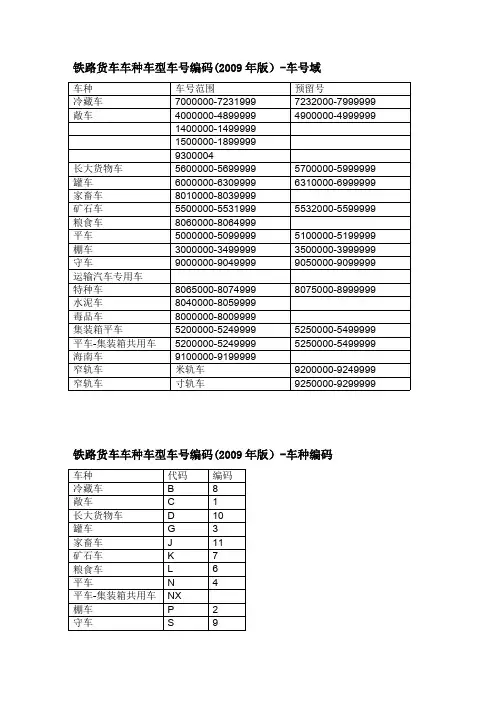
铁路货车车种车型车号编码(2009年版)-车号域车种车号范围预留号冷藏车7000000-72319997232000-7999999敞车4000000-48999994900000-4999999 1400000-1499999 1500000-1899999 9300004长大货物车5600000-56999995700000-5999999罐车6000000-63099996310000-6999999家畜车8010000-8039999 矿石车5500000-55319995532000-5599999粮食车8060000-8064999 平车5000000-50999995100000-5199999棚车3000000-34999993500000-3999999守车9000000-90499999050000-9099999运输汽车专用车 特种车8065000-80749998075000-8999999水泥车8040000-8059999 毒品车8000000-8009999 集装箱平车5200000-52499995250000-5499999平车-集装箱共用车5200000-52499995250000-5499999海南车9100000-9199999 窄轨车米轨车9200000-9249999窄轨车寸轨车9250000-9299999铁路货车车种车型车号编码(2009年版)-车种编码车种代码编码冷藏车B 8敞车C 1长大货物车D 10罐车G 3家畜车J 11矿石车K 7粮食车L 6平车N 4平车-集装箱共用车NX 棚车P 2守车S911运输汽车专用车SQ 特种车T 13水泥车U 14毒品车W 12集装箱平车X5铁路货车车种车型车号编码(2009年版)-罐车号域罐车车型起始号终止号G17/K/T/D/DK/DT/G 60800006139999G17B/BK/BT 61400006169999G1862000006209999G60/A/K/T 62200006259999G70AK/K/T 62700006299999G70B 64000006449999G70H 64500006499999G75K 65000006529999GF1M/MK 63500006354999GL7063550006359999GQ7066000006649999GN7067000006749999G10自备车 G11自备车 G11A/AK/BK/J/JE 自备车 G11JK/JT/K/L/S 自备车 G11SE/SK/ST/T 自备车 G12/S 自备车 G14自备车 G15/E 自备车 G16自备车 G17/B/BK/D/DK/E 自备车 G17K/S/SK/T 自备车 G18/K 自备车 G19自备车 G50/K自备车 G60/A/E/H/HK/K 自备车 G60LB/T/K/TLB/XK 自备车 G70/E/K/T 自备车 G73自备车 G75K 自备车 GAL/K 自备车 GF 自备车 GF1自备车 11 01628GF18K自备车 GF1E/K/T 自备车 GF2/E/ET/K/T 自备车 GF3/K 自备车 GF70自备车 GFA/AE/AK/AT/K 自备车 GH自备车 GH11/K 自备车 GH17/K 自备车 GH37自备车 GH40/K/L/LK 自备车 GH50/AK/EK/K自备车 GH60/A/AK/CK/DK/EK/K 自备车 GH65K 自备车 GH70/A/K 自备车 GHA70/A 自备车 GHB55K 自备车 GHB60自备车 GHE 自备车 GHK 自备车 GJ70自备车 GL 自备车 GL12S 自备车 GL17/K 自备车 GL60K 自备车 GL70自备车 GLA/K自备车 GLB/BE/BK/BT 自备车 GLC/CE/CK/CT 自备车 GLK 自备车 GN自备车 GN17/K 自备车 GN60自备车 GN70/A 自备车 GNK 自备车 GQ自备车 GQ60/K 自备车 GQ70自备车 GS 自备车 GS11自备车 GS70自备车 GSK 自备车 GY 自备车 11 01628GY100/K/S 自备车 GY10AK/S/SK 自备车 GY30自备车 GY40/S/SK 自备车 GY45/S/SK 自备车 GY48/K/S 自备车 GY50/C/S/W 自备车 GY55自备车 GY60/C/K/S/SK/W 自备车 GY65/S自备车 GY70/C/K/S/SK/W 自备车 GY75/S自备车 GY80/A/E/K/S/SE/SK 自备车 GY95/A/AK/K/S/SK/W 自备车 其中6101190-6101289为G17B铁路货车车种车型车号编码(2009年版)-棚车号棚车车型起始号终止号备注P6130600003079999 P62/K/T31000003299999 P62N/NK/NT 33100003399999 P63K 33000003309999 P64K/T34000003419999 P64A/AK/AT 34200003459999 P64GK/GT 34600003479999 P64GH 36000003649999 P6535000003599999 PT 37000003719999 P66H 37200003739999 P66K 37400003759999 P70/H 38000003899999 PB 77000007799999 P50 自备车P60 自备车P61 自备车P62 自备车P62K/N/NK 自备车P64 自备车P64A/AK/GK自备车铁路货车车种车型车号编码(2009年版)-敞车号11 28敞车车型对应的车号域敞车车型起始号终止号备注C16/AK/K 4170000/14850004173999/1485999 C61/E/K/T 43000004319999 C61Y 43200004324999 C624100000/14800004139999/1482999 C62A/AT/AK4400000/4500000/14000004499999/4599999/1429999C62B/BT/BK 4600000/14300004799999/1449999 C6343250004325999 C63A 43260004349999 C64A/AT 49990004999999 C64H 42000004299999 C64K 1450000/48000001469999/4998999 C64T 1450000/48000001469999/4998999 C654176000/14840004199999/1484999 C70/B/F 15500001899999 C70BH/H 15000001549999 C70X 93000049300004 C76/B 43530004353999 C76A/H 43500004352999 C76C 43540004354999 C80/A/B/BF/C/CA 43700004389999 C80H/AH/BH 43900004399999 CF 4174000/14860004175999/1486999 C62A*45000004599999 C62A*K 45000004599999 C62A*T 45000004599999 C100A/AH 自备车C16K 自备车C50 自备车C62 自备车C62A/AK 自备车C62B/BK 自备车C62M 自备车C64/H/K 自备车C65 自备车C70/A 自备车CF 自备车IC6G/GK 自备车4 11 01628铁路货车车种车型车号编码(2009年版)-自备车号域铁路局号域哈局0110000-0159999沈局0200000-0289999京局0310000-0369999呼局0410000-0499999郑局0510000-0569999济局0870000-0899999上局0610000-0659999南局0680000-0699999广铁0710000-0739999宁局0760000-0779999成局0810000-0849999昆局0850000-0859999兰局0910000-0949999乌局0960000-0999999青藏0930000-0939999西局0550000-0589999武局0530000-0549999太局0340000-0359999P64GK型棚车性能参数: 自重 24.0 t 载重 60.0 t 有效容积 135.0 m3 长度 16438 mm 构造速度 100 km/hP64GT型通用棚车基本数据:载重:60吨自重:23.8吨容积:135立方米换长:1.5米铁路货车类型及相应车号范围(一)铁路货车类型及相应车号范围(十)作者:北雪编辑来源: 中国铁路更新时间: 2008-10-29440PG20 441PG28 442PG30 443PL 1 444PN9 445QD3 8自备车446S10 447S11900000090099993722 448S1290100009029999 449S1390300009049999 450S14 451S23 452SQ1 453SQ2 454SQ3 455SQ3K 456SQ4 457T072000012000033 458T680664008066799 459T6D 80662008066399 460T6F 80660008066199 461T6Y 462T780668008066999 463T980670008067499 464T1080675008067999 465T1180745008074999 466T11A 80700008074499 467T11B 80760008079999 468T11BT 80760008079999 469T1280750008075999 470T12J 80750008075999 471T12Q 80750008075999 472T38 473T53 自备车474T6080680008068999 475T64 自备车11。
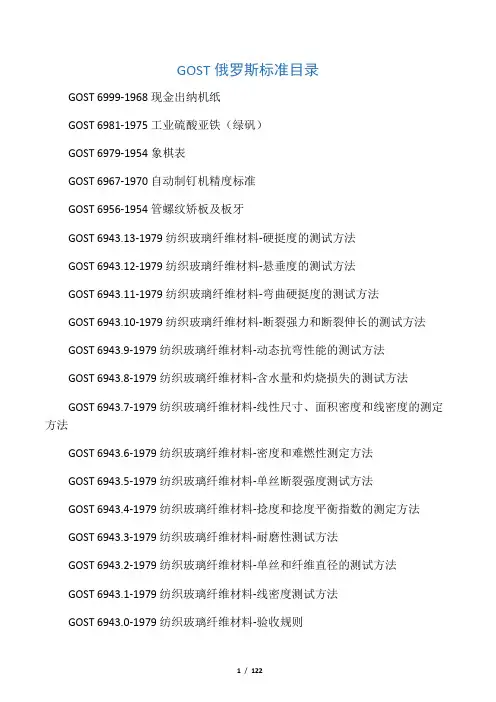
GOST俄罗斯标准目录GOST 6999-1968现金出纳机纸GOST 6981-1975工业硫酸亚铁(绿矾)GOST 6979-1954象棋表GOST 6967-1970自动制钉机精度标准GOST 6956-1954管螺纹矫板及板牙GOST 6943.13-1979纺织玻璃纤维材料-硬挺度的测试方法GOST 6943.12-1979纺织玻璃纤维材料-悬垂度的测试方法GOST 6943.11-1979纺织玻璃纤维材料-弯曲硬挺度的测试方法GOST 6943.10-1979纺织玻璃纤维材料-断裂强力和断裂伸长的测试方法GOST 6943.9-1979纺织玻璃纤维材料-动态抗弯性能的测试方法GOST 6943.8-1979纺织玻璃纤维材料-含水量和灼烧损失的测试方法GOST 6943.7-1979纺织玻璃纤维材料-线性尺寸、面积密度和线密度的测定方法GOST 6943.6-1979纺织玻璃纤维材料-密度和难燃性测定方法GOST 6943.5-1979纺织玻璃纤维材料-单丝断裂强度测试方法GOST 6943.4-1979纺织玻璃纤维材料-捻度和捻度平衡指数的测定方法GOST 6943.3-1979纺织玻璃纤维材料-耐磨性测试方法GOST 6943.2-1979纺织玻璃纤维材料-单丝和纤维直径的测试方法GOST 6943.1-1979纺织玻璃纤维材料-线密度测试方法GOST 6943.0-1979纺织玻璃纤维材料-验收规则GOST 6940-1974交换机用白炽灯GOST 6939-1971灌木沼泽犁GOST 6927-1974混凝土外墙装饰技术条件GOST 6926-1975不透光纸GOST 6923-1984工业用辐射温度计一般技术要求GOST 6915-1971间接测量动脉压力的指示式压力仪器GOST 6862-1971永磁合金棒GOST6861-1973彩色书写纸GOST 6860-1968带有电磁式上条机构的汽车钟技术条件GOST 6855-1973框架开榫机主要参数与规格GOST 6854-1977细木工带锯机基本参数与尺寸GOST 6851.3-1977 6MTC-22型铅酸蓄电池技术条件GOST 6851.2-1977 6MTC-9型铅酸蓄电池技术条件GOST 6851.1-1977 3MT-8型铅酸蓄电池技术条件GOST 6851.0-1977摩托车和小型摩托车用铅蓄电池一般技术条件GOST 6850-1976 16mm电影放映机类型、基本参数、技术要求GOST 6826-1978木工四面刨床基本参数与尺寸GOST 6825-1974荧光灯GOST 6810-1974糊墙纸GOST 6809-1970热模锻曲柄压力机基本参数和尺寸GOST 6808-1976空气锤精度标准GOST 6800-1954带有电磁式上条机构的汽车钟技术条件GOST 6787-1980陶瓷地砖技术条件GOST 6787-1969陶瓷地砖GOST 6766-1973剪板机精度标准GOST 6765-1975热轨三层钢板和宽钢带GOST 6756-1957辛香料咸图贡白鲑、索西瓦鲱鱼、欧洲白鲑和高白鲑(桶装)GOST 6749-1974糊墙纸原纸GOST 6746-1975电容量具一般技术条件GOST 6742-1968内封页纸GOST 6727-1980加强钢筋混凝土结构用冷拉低碳钢钢丝GOST 6724-1977拱式和桥式蒸汽空气双作用锻缸精度标准GOST 6723-1972自动切边机精度标准GOST 6722-1975工业过滤纸板GOST 6713-1975桥梁建造用低合金结构钢。
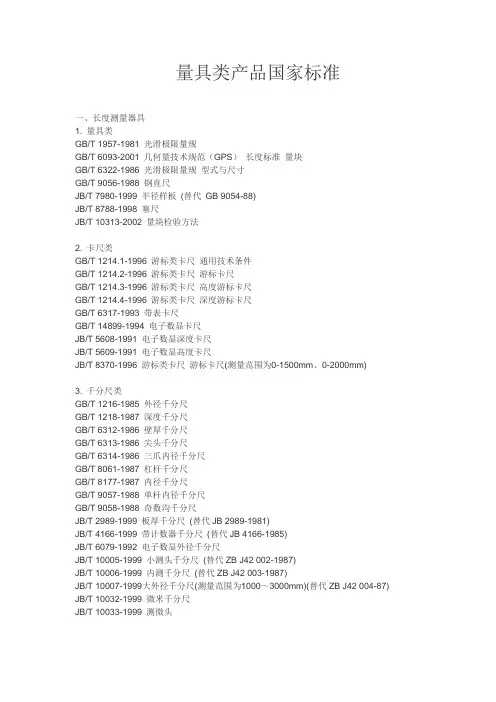
量具类产品国家标准一、长度测量器具1. 量具类GB/T 1957-1981 光滑极限量规GB/T 6093-2001 几何量技术规范(GPS)长度标准量块GB/T 6322-1986 光滑极限量规型式与尺寸GB/T 9056-1988 钢直尺JB/T 7980-1999 半径样板(替代GB 9054-88)JB/T 8788-1998 塞尺JB/T 10313-2002 量块检验方法2. 卡尺类GB/T 1214.1-1996 游标类卡尺通用技术条件GB/T 1214.2-1996 游标类卡尺游标卡尺GB/T 1214.3-1996 游标类卡尺高度游标卡尺GB/T 1214.4-1996 游标类卡尺深度游标卡尺GB/T 6317-1993 带表卡尺GB/T 14899-1994 电子数显卡尺JB/T 5608-1991 电子数显深度卡尺JB/T 5609-1991 电子数显高度卡尺JB/T 8370-1996 游标类卡尺游标卡尺(测量范围为0-1500mm、0-2000mm)3. 千分尺类GB/T 1216-1985 外径千分尺GB/T 1218-1987 深度千分尺GB/T 6312-1986 壁厚千分尺GB/T 6313-1986 尖头千分尺GB/T 6314-1986 三爪内径千分尺GB/T 8061-1987 杠杆千分尺GB/T 8177-1987 内径千分尺GB/T 9057-1988 单杆内径千分尺GB/T 9058-1988 奇数沟千分尺JB/T 2989-1999 板厚千分尺(替代JB 2989-1981)JB/T 4166-1999 带计数器千分尺(替代JB 4166-1985)JB/T 6079-1992 电子数显外径千分尺JB/T 10005-1999 小测头千分尺(替代ZB J42 002-1987)JB/T 10006-1999 内测千分尺(替代ZB J42 003-1987)JB/T 10007-1999大外径千分尺(测量范围为1000~3000mm)(替代ZB J42 004-87) JB/T 10032-1999 微米千分尺JB/T 10033-1999 测微头4. 指示表类GB/T 1219-2000 几何量技术规范长度测量器具:指示表设计及计量技术要求GB/T 4755-1984 扭簧比较仪GB/T 6311-1986 大量程百分表GB/T 6320-1997 杠杆齿轮比较仪GB/T 6321-1986 光学扭簧测微计GB/T 8122-1987 内径百分表GB/T 8123-1998 杠杆指示表GB/T 18761-2002 电子数显指示表JB/T 3237-1991 杠杆卡规JB/T 3712-1998 小扭簧比较仪JB/T 5214-1991 曲轴量表JB/T 5216-1991 硫化机测力表JB/T 6081-1992 深度百分表JB/T 7429-1994 电子塞规JB/T 8346-1996 带表卡尺指示表JB/T 8499-1996 电子柱电感测微仪JB/T 8787-1998 峰值电感测微仪JB/T 8790-1998 钢球式内径百分表JB/T 8791-1998 涨簧式内径百分表JB/T 10014-1999 数显电感测微仪JB/T 10016-1999 测厚规JB/T 10017-1999 带表卡规JB/T 10035-1999 厚度表JB/T 10036-1999 电感式测微仪二、角度测量器具GB/T 6092-1985 90°角尺GB/T 6315-1996 游标万能角度尺GB/T 10943-1989 1:4圆锥量规GB/T 11852-1989 圆锥量规公差与技术条件GB/T 11853-1989 莫氏与公制圆锥量规GB/T 11854-1989 7:24工具圆锥量规GB/T 11855-1989 钻夹圆锥量规JB/T 3325-1999 角度量块及其附件(替代JB 3325-83)JB/T 7973-1999 正弦规(替代GB 4973-85)JB/T 8789-1998 1:24(UG)圆锥量规JB/T 10015-1999 直角尺检查仪JB/T 10018-1999 正多面棱体JB/T 10026-1999 带表万能角度尺JB/T 10027-1999 方形角尺(方箱)三、形位误差测量器具GB/T 6091-1985 刀口形直尺GB/T 16455-1996 条式和框式水平仪JB/T 3238-1999 合像水平仪(替代JB 3238-83)JB/T 7974-1999 铸铁平板(替代GB 4986-85)JB/T 7975-1999 岩石平板(替代GB 4987-85)JB/T 7977-1999 铸铁平尺(替代GB 6318-86)JB/T 7978-1999 钢平尺和岩石平尺(替代GB 6319-86)JB/T 10038-1999 电子水平仪JB/T 10028-1999 圆度仪四、表面质量测量器具GB/T 6060.1-1997 表面粗糙度比较样块铸造表面(替代GB 6060.1-85) GB/T 6060.2-1985 表面粗糙度比较样块机械加工表面GB/T 6060.3-1986 表面粗糙度比较样块电火花加工表面GB/T 6060.4-1988 表面粗糙度比较样块抛光加工表面GB/T 6060.5-1988 表面粗糙度比较样块喷砂抛丸加工表面GB/T 6062-1985 轮廓法触针式表面粗糙度测量仪轮廓记录仪及中线制轮廓计五、齿轮测量器具GB/T 1217-1986 公法线千分尺GB/T 5106-1985 圆柱直齿渐开线花键量规GB/T 6316-1996 齿厚游标卡尺GB/T 10919-1989 矩形花键量规JB/T 6080-1992 电子数显齿厚卡尺JB/T 10008-1999 测量蜗杆JB/T 10012-1999 万能测齿仪JB/T 10013-1999 万能渐开线检查仪JB/T 10019-1999 齿轮齿距测量仪(原齿轮周节测量仪)JB/T 10020-1999 万能齿轮测量机JB/T 10021-1999 齿轮螺旋线测量仪JB/T 10022-1999 便携式齿轮齿距测量仪JB/T 10023-1999 便携式齿轮基节测量仪JB/T 10024-1999 立式滚刀测量仪JB/T 10025-1999 齿轮双面啮合综合测量仪JB/T 10029-1999 齿轮单面啮合整体误差测量仪六、螺纹测量器具GB/T 1581-1979 米制锥螺纹量规GB/T 3934-1983 普通螺纹量规GB/T 8124-1987 梯形螺纹量规技术条件GB/T 8125-1987 梯形螺纹量规型式与尺寸GB/T 10920-1989 普通螺纹量规型式与尺寸GB/T 10922-1989 非螺纹密封管螺纹量规GB/T 10932-1989 螺纹千分尺JB/T 1128-1999 间隙螺纹量规(替代JB 1128-70)JB/T 3326-1999 量针(替代JB 3326-83)JB/T 7981-1999 螺纹样板(替代GB 9055-88)JB/T 10031-1999 用螺纹密封的管螺纹量规七、其它测量器具JB/T 5213-1991 内、外圆磨加工主动测量仪技术条件JB/T 5215-1991 开关触发式三维传感系统JB/T 7982-1999 刀具预调测量仪精度(替代GB 10921-89)八、测量链JB/T 3760-1991 浮标式气动量仪JB/T 4167-1999 薄膜式气动量仪(替代JB 4167-85)JB/T 5212-1991 气动测量头技术条件JB/T 5610-1991 双频激光干涉仪JB/T 8371-1996 容栅线位移测量系统数显单元0.01mmJB/T 10037-1999 磁栅线位移测量系统JB/T 10030-1999 光栅线位移测量系统JB/T 10034-1999 光栅角位移测量系统九、通用器件及附件JB/T 8047-1999 V形架(替代GB 4972-85)JB/T 3323-2001 量块附件JB/T 10009-1999 比较仪座(替代ZB J42 007-87)JB/T 10010-1999 磁性表座(替代ZB J42 008-87)JB/T 10011-1999 万能表座(替代ZB J42 009-87)十、术语GB/T 17163-1997 几何量测量器具术语基本术语GB/T 17164-1997 几何量测量器具术语产品术语JB/T 7976-1999 轮廓法测量表面粗糙度的仪器术语(替代GB 6061-85) GB/T 8372-1996 几何量测量仪器型号编制方法十一、产品分等标准JB/T 54247.1-1996 量具量仪产品质量分等通则JB/T 54247.2-1996 量具量仪产品质量分等抽样验收细则JB/T 50047-1999 量具量仪产品质量分等电子塞规JB/T 50114-1998 量具量仪产品质量分等游标万能角度尺JB/T 50146-2000 量具量仪产品质量分等涨簧式内径百分表JB/T 50147-2000 量具量仪产品质量分等小扭簧比较仪JB/T 50148-2000 量具量仪产品质量分等钢球式内径百分表JB/T 54248-2000 量具量仪产品质量分等指示表JB/T 54250-1994 杠杆百分表产品质量分等标准(替代JB/GQ.F 5053-86) JB/T 54251-1994 杠杆千分表产品质量分等标准(替代JB/GQ.F 5054-86)JB/T 54252-1998 量具量仪产品质量分等游标卡尺JB/T 54253-1994 带表卡尺产品质量分等标准(替代JB/GQ.F 5057-86)JB/T 54254-1999 量具量仪产品质量分等外径千分尺JB/T 54255-1999 量具量仪产品质量分等杠杆千分尺JB/T 54256-1994 量块产品质量分等标准(替代JB/GQ.F 5061-86)JB/T 54257-1994 刀口尺产品质量分等标准(替代JB/GQ.F 5062-86)JB/T 54258-1994 水平仪产品质量分等标准(替代JB/GQ.F 5063-86)JB/T 54259-1999 量具量仪产品质量分等光滑极限量规JB/T 54260-1999 量具量仪产品质量分等铸铁平板JB/T 54261-1999 量具量仪产品质量分等岩石平板JB/T 54262-1999 量具量仪产品质量分等铸铁平尺JB/T 54263-1999 量具量仪产品质量分等钢平尺和岩石平尺JB/T 54265-1999 量具量仪产品质量分等浮标式气动量仪JB/T 54272-1999 量具量仪产品质量分等公法线千分尺JB/T 54273-1998 量具量仪产品质量分等齿厚游标卡尺JB/T 54274-1994 杠杆齿轮比较仪产品质量分等标准(替代JB/GQ.F 5079-88) JB/T 54275-1999 量具量仪产品质量分等小测头千分尺JB/T 54276-1999 量具量仪产品质量分等奇数沟千分尺JB/T 54277-1999 量具量仪产品质量分等壁厚千分尺JB/T 54278-1998 量具量仪产品质量分等高度游标卡尺JB/T 54279-1999 量具量仪产品质量分等尖头千分尺JB/T 54280-1999 量具量仪产品质量分等深度千分尺JB/T 54281-1998 量具量仪产品质量分等深度游标卡尺JB/T 54282-1999 量具量仪产品质量分等微米千分尺JB/T 54283-1999 量具量仪产品质量分等电子数显卡尺JB/T 54285-1999 量具量仪产品质量分等测微头JB/T 54286-1994 塞尺产品质量分等标准(替代JB/GQ.F 5092-90)JB/T 54288-1999 量具量仪产品质量分等电子数显深度卡尺JB/T 54289-1999 量具量仪产品质量分等电子数显高度卡尺JB/T 54819-1992 电子数显外径千分尺产品质量分等标准JB/T 54820-1992 万能渐开线检查仪产品质量分等标准JB/T 54821-1992 万能齿轮测量机产品质量分等标准JB/T 54822-1992 齿轮螺旋线测量仪产品质量分等标准JB/T 54823-1992 齿轮双面啮合综合测量仪产品质量分等标准十二、出口产品标准LB 001-95 英制指示表LB 002-98 带标尺的直角钢尺ZB J42 031 89 游标卡尺(测量上限为1500mm和2000mm)JB 5608-91 电子数显深度卡尺JB 5609-91 电子数显高度卡尺JB 5680-92 电子数显齿厚卡尺GB 1218-87 深度千分尺GB 9057-88 单杆式内径千分尺GB 9058-88 奇数沟千分尺ZB J42 038-90 微米千分尺ZB J42 039-90 测微头JB 6079-92 电子数显外径千分尺ZB J42 021-88 涨簧式内径百分表ZB J42 041-90 厚度表JB 3237-91 杠杆卡规JB 5214-91 曲轴量表JB 5216-91 硫化机测力表JB 6081-92 深度百分表ZB J42 007-87 比较仪座ZB J42 008-87 磁性表座ZB J42 009-87 万能表座ZB J42 016-87 正多面棱体ZB J42 028-88 方形角尺GB 9056-88 钢直尺GB 6060.4-88 表面粗糙度比较样块抛光加工表面GB 6060.5-88 表面粗糙度比较样块抛(喷)丸、喷沙加工表面GB 9054-88 半径样板GB 9055-88 螺纹样板GB 11852-89 圆锥量规公差与技术条件GB 11853-89 莫氏与公制圆锥量规GB 11854-89 7:24工具圆锥量规GB 11855-89 钻夹圆锥量规GB 10919-89 矩形花键量规GB 10920-89 普通螺纹量规型式与尺寸GB 10922-89 非螺纹密封的管螺纹量规ZB J42 037-89 用螺纹密封的管螺纹量规ZB J42 013-87 直角尺检查仪ZB J42 012-87 数显电感测微仪ZB J42 018-88 齿轮周节测量仪ZB J42 019-88 万能齿轮测量仪ZB J42 020-88 齿轮螺旋线测量仪ZB J42 022-88 便携式齿轮周节测量仪ZB J42 023-88 便携式齿轮基节测量仪ZB J42 024-88 立式滚刀测量仪ZB J42 025-88 齿轮双面啮合综合周节测量仪GB 10921-89 刀具预调测量仪精度ZB J42 027-88 电子水平仪ZB J42 030-88 圆度仪ZB J42 032-89 齿轮单面啮合整体误差测量仪ZB J42 033-89 瓷栅线位移测量系统ZB J42 034-89 瓷栅线位移传感器技术条件ZB J42 036-89 光栅线位移测量系统ZB J42 040-90 光栅角位移测量系统ZB J42 042-90 电感式测微仪JB 3760-91 浮标式气动量仪JB 5212-91 气动测量头技术条件JB 5213-91 内、外圆磨加工主动测量仪技术条件JB/T 6082-92 触发传感器系统系列型谱JB 5215-91 开关触发式三维传感器系统JB 5610-91 双频激光干涉仪。
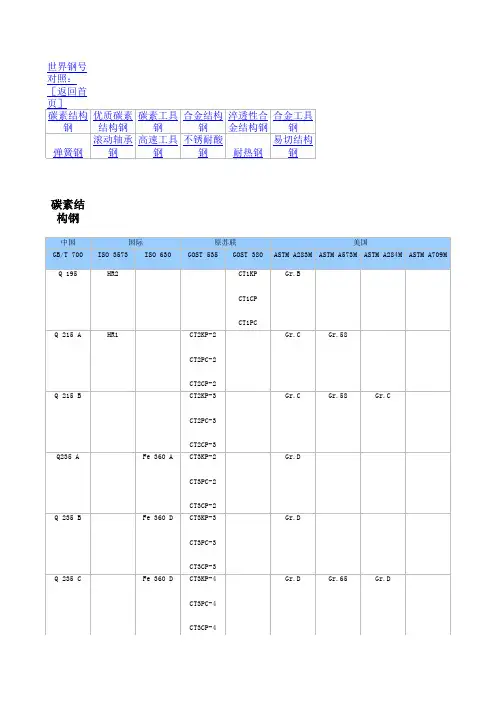
常用碳钢焊条新旧牌号对照及适用范围.txt爱,就大声说出来,因为你永远都不会知道,明天和意外,哪个会先来!石头记告诉我们:凡是真心爱的最后都散了,凡是混搭的最后都团圆了。
你永远看不到我最寂寞的时候,因为在看不到你的时候就是我最寂寞的时候!不锈钢焊条新旧牌号对照最近更新时间:2009年6月15日提供商:无锡太湖石化装备厂资料大小:0文件类型:/下载次数:0次资料类型:浏览次数:543 次相关产品:详细介绍:一、不锈钢焊条新旧牌号对照及适用范围国家标准GB983-77 国家标准GB983-85 国家标准GB983-95 烘干适用于焊接钢材A002 E00-19-10-16 E308L-16 150℃×1 h 0Cr19Ni10; 0Cr19Ni11Ti;A022 E00-18-12Mo-16 E316L-16 00Cr17Ni14 Mo2A032 E00-19-13Mo2-Cu2-16 E317 Mo-CuL-16 0Cr18Ni12Mo2Cu2A042 E00-23-13Mo2-16 E309 Mo L-16 00Cr23Ni13Mo2A062 E00-23-13-16 E309 L-16 00Cr23Ni13A101 E0-19-10-16 E308-16 1Cr19Ni9; Cr19Ni10; 0Cr19Ni11A102 E0-19-10-16 E308-16 0Cr19Ni9; 0Cr19Ni11TiA107 E0-19-10-15 E308-15 250℃×1 h 0Cr19Ni9A132 E0-19-10Nb-16 E347-16 150℃×1 h Cr19Ni11TiA137 E0-19-10Nb-15 E347-15 250℃×1 h 0Cr19Ni11TiA201 E0-18-12Mo2-16 E316-16 250℃×1 h(禁反复烘) 0Cr18Ni12Mo2A202 E0-18-12Mo2-16 E316-16 150℃×1 h 0Cr18Ni12Mo2A207 E0-18-12Mo2-15 E316-15 250℃×1 h 0Cr18Ni12Mo2; Cr13; Cr17A242 E0-19-13Mo3-16 E317-16 150℃×1 h Cr19Ni13Mo3A302 E1-23-13-16 E309-16 Cr23Ni13A307 E1-23-13-15 E309-15 250℃×1 h Cr23Ni13A312 E1-23-13Mo2-16 E309 Mo -16 150℃×1 h Cr23Ni13Mo2A402 E2-26-21-16 E310 -16 Cr25Ni20A407 E2-26-21-15 E310 -15 250℃×1 h Cr25Ni20A412 E1-21-21Mo2-16 E310Mo -16 150℃×1 h Cr26Ni21Mo2A422 Cr25Ni20Si2说明:15、25—碱性,直流反接; 16、17、26—钛钙型,交流或直流反接。
6135系列缸盖产品对照表6135系列缸盖总长为339±0.30,宽为251,厚为128±0.08型号气门凸凹度订货图号6135G 凹陷1.45~2.25761G-04-020b6135AG 凸0.25~凹0.55A761G-04-02012V135 凹陷1.45~2.25771-04-02012V135AG 凸0.25~凹0.55A771-04-0206135ZG 凹陷1.45~2.25761Z-04-02012V135Z 凹陷1.45~2.25771Z-04-0206135Q-1 凸0.3~凹0.45763Ca-04-020 改进型6135Q-1a 凸0.3~凹0.45763Ca-04-020 6135JZ 凸0.3~凹0.45761JZ-04-020注:12v135(771-04-020)与6135G(761-04-020d)部分区别1.下面多2—¢7水孔2.进气面多2-¢20水孔及4-M8丝孔其余相同12v135Z1.进气面比6135ZG多2-¢20水孔及4-M8丝孔2.下面多2—¢7水孔761JZ与A761区别1.进气导管高26,排气导管高202.座圈厚度(763座圈)3.凡尔线进气30度,排气45度4.进气座圈倒角30度,其余同A761相同771JZ 部分尺寸区别1.进气导管高26,排气导管高202.进气面多进气面多2-¢20水孔及4-M8丝孔3.下面多2—¢7水孔4.进气座圈倒角30度,凡尔线30度,排气45度,其余同A761771AZD部分区别1.进气座圈孔深140-0.42,倒角3*30度,排气座圈深140-0.42,倒角4.5*45度,进气弹簧座深23.5±0.30,排气弹簧座深20±0.302.下面多2—¢7水孔,进气面多2-¢20水孔及4-M8丝孔3.喷油孔¢9.6深16.4(同G、AG)4.喷油嘴¢9.6用R2.5刀具倒角,需控制与进气门间不得穿通。
NT6135G型工程机械用柴油机
刘德才
【期刊名称】《工程机械》
【年(卷),期】1998(029)002
【摘要】介绍南通柴油机股份有限公司新研制的NT6135G型工程机械用柴
油机,该机是原生产的6135K-9和6135Q-1型柴油机的改进型新产品,以提高动力性和工作可靠性,降低油耗与噪声,减少排气污染为目的而进行改进研制产品,并达到预期要求。
【总页数】4页(P3-6)
【作者】刘德才
【作者单位】南通柴油机股份有限公司
【正文语种】中文
【中图分类】TU603
【相关文献】
1.NT6135U型柴油机的研制与开发
2.NT6135ZLDU2型柴油机的开发
3.NT6135ZDR柴油机的研制
4.NT6135ZR柴油机燃烧室的设计
5.NT4135R、
NT6135R柴油机的研制与开发
因版权原因,仅展示原文概要,查看原文内容请购买。
6135ZCAF增压柴油机技术数据6135ZCAF增压柴油机技术数据1.喷油提前角28~31°2.油底壳机油温度≤95℃3.循环冷却水最高温度≤95℃4.机油压力(凸轮轴尾端)标转2.5~3.5kg∕cm25.气缸盖螺母M16×1.5 265~294N.M6.连杆螺钉M18×1.5 255~274N.M7.进气门间隙0.30~0.35mm8.排气门间隙0.35~0.40mm9.第一道气环天地间隙0.100~0.135mm,极限0.2510.第二道气环天地间隙0.080~0.115mm,极限0.2211.第三道气环天地间隙0.070~0.105mm,极限0.2012.刮油环天地间隙0.060~0.098mm,极限0.1813.第一道气环(镀铬环)搭口0.600~0.800mm,极限2.0014.第二三道气环搭口间隙0.500~0.700mm,极限2.0015.油环搭口间隙0.400~0.600mm,极限2.000.12~0.35mm16.机油泵齿轮与其传动齿轮齿隙(泵与机体之间有耐油垫片,勿漏装,否则泵轴易断)17.连杆轴颈与连杆大头轴承孔0.080~0.151mm,极限0.25018.曲轴主轴颈与滚子轴承内圈过盈,0.060~0.105mm19.进气门角度30° 20.排气门角度45°21.缸套(φ135+0.04mm )如磨损到一定限度或外部穴蚀深度超过2mm 换新 22.喷油器喷射压力 190+10kgf /cm 2 23.针阀偶件代号(图号)3127E-10(761-28I-000)24.齿轮泵齿轮的端面与盖板间隙0.05~0.115mm 25.齿轮泵从动齿轮孔与从动轴的配合间隙0.03~0.082mm 26.每小时耗油量(40,60,80,100,120,140KW 有效功率) 10,15,19,23,27,31kg ∕h 每小时耗油量(Gt ) 27.燃油消耗率ge(g ∕kw.h)(40,60,80,100,120,140kw 有效功率时) 270,245,230,222,220,225g/kw.h 28.排气温度300—550℃。
SS9-0001 上局沪段SS9-0081 京局京段SS9-0161 济局济段SS9-0002 上局沪段SS9-0082 沈局沈段SS9-0162 济局济段SS9-0003 上局沪段SS9-0083 沈局沈段SS9-0163 上局沪段SS9-0004 沈局沈段SS9-0084 沈局沈段SS9-0164 上局沪段SS9-0005 沈局沈段SS9-0085 沈局沈段SS9-0165 上局杭段SS9-0006 沈局沈段SS9-0086 沈局沈段SS9-0166 上局杭段SS9-0007 上局沪段SS9-0087 沈局沈段SS9-0167 上局沪段SS9-0008 上局沪段SS9-0088 沈局沈段SS9-0168 上局沪段SS9-0009 沈局沈段SS9-0089 沈局沈段SS9-0169 上局沪段SS9-0010 上局沪段SS9-0090 沈局沈段SS9-0170 上局沪段SS9-0011 沈局沈段SS9-0091 沈局沈段SS9-0171 上局沪段SS9-0012 上局沪段SS9-0092 广铁广段SS9-0172 上局沪段SS9-0013 沈局沈段SS9-0093 广铁广段SS9-0173 上局沪段SS9-0014 沈局沈段SS9-0094 广铁广段SS9-0174 京局京段SS9-0015 沈局沈段SS9-0095 广铁广段SS9-0175 京局京段SS9-0016 沈局沈段SS9-0096 广铁广段SS9-0176 京局京段SS9-0017 沈局沈段SS9-0097 广铁广段SS9-0177 京局京段SS9-0018 沈局沈段SS9-0098 广铁广段SS9-0178 京局京段SS9-0019 沈局沈段SS9-0099 广铁广段SS9-0179 京局京段SS9-0020 沈局沈段SS9-0100 广铁广段SS9-0180 京局京段SS9-0021 沈局沈段SS9-0101 广铁广段SS9-0181 京局京段SS9-0022 上局沪段SS9-0102 京局京段SS9-0182 京局京段SS9-0023 沈局沈段SS9-0103 京局京段SS9-0183 京局京段SS9-0024 沈局沈段SS9-0104 京局京段SS9-0184 京局京段SS9-0025 沈局沈段SS9-0105 京局京段SS9-0185 京局京段SS9-0026 沈局沈段SS9-0106 京局京段SS9-0186 京局京段SS9-0027 沈局沈段SS9-0107 京局京段SS9-0187 南局南段SS9-0028 沈局沈段SS9-0108 京局京段SS9-0188 济局济段SS9-0029 沈局沈段SS9-0109 京局京段SS9-0189 济局济段SS9-0030 沈局沈段SS9-0110 京局京段SS9-0190 南局南段SS9-0031 沈局沈段SS9-0111 京局京段SS9-0191 南局南段SS9-0032 沈局沈段SS9-0112 沈局沈段SS9-0192 南局南段SS9-0033 沈局沈段SS9-0113 沈局沈段SS9-0193 南局南段SS9-0034 沈局沈段SS9-0114 沈局沈段SS9-0194 南局南段SS9-0035 沈局沈段SS9-0115 沈局沈段SS9-0195 上局沪段SS9-0036 沈局沈段SS9-0116 沈局沈段SS0-0196 广铁广段SS9-0037 沈局沈段SS9-0117 沈局沈段SS0-0197 广铁广段SS9-0038 沈局沈段SS9-0118 沈局沈段SS0-0198 广铁广段SS9-0039 沈局沈段SS9-0119 沈局沈段SS0-0199 沈局沈段SS9-0040 沈局沈段SS9-0120 京局京段SS9-0200 沈局沈段SS9-0041 沈局沈段SS9-0121 京局京段SS9-0201 沈局沈段SS9-0042 上局沪段SS9-0122 京局京段SS9-0202 沈局沈段SS9-0043 上局沪段SS9-0123 京局京段SS9-0203 沈局沈段SS9-0044 上局沪段SS9-0124 京局京段SS9-0204 沈局沈段SS9-0045 上局沪段SS9-0125 武局南段SS9-0205 沈局沈段SS9-0046 沈局沈段SS9-0126 武局南段SS9-0206 沈局沈段SS9-0047 沈局沈段SS9-0127 武局南段SS9-0207 沈局沈段SS9-0048 沈局沈段SS9-0128 武局南段SS9-0208 沈局沈段SS9-0049 沈局沈段SS9-0129 武局南段SS9-0209 南局南段SS9-0050 沈局沈段SS9-0130 武局南段SS9-0210 南局南段SS9-0051 沈局沈段SS9-0131 武局南段SS9-0211 南局南段SS9-0052 沈局沈段SS9-0132 武局南段SS9-0212 南局南段SS9-0053 沈局沈段SS9-0133 武局南段SS9-0213 南局南段SS9-0054 沈局沈段SS9-0134 武局南段SS9-0055 沈局沈段SS9-0135 武局南段SS9-0056 沈局沈段SS9-0136 武局南段SS9-0057 沈局沈段SS9-0137 武局南段SS9-0058 沈局沈段SS9-0138 武局南段SS9-0059 沈局沈段SS9-0139 武局南段SS9-0060 沈局沈段SS9-0140 武局南段SS9-0061 沈局沈段SS9-0141 武局南段SS9-0062 沈局沈段SS9-0142 武局南段SS9-0063 沈局沈段SS9-0143 武局南段SS9-0064 沈局沈段SS9-0144 武局南段SS9-0065 沈局沈段SS9-0145 京局京段SS9-0066 沈局沈段SS9-0146 京局京段SS9-0067 沈局沈段SS9-0147 京局京段SS9-0068 沈局沈段SS9-0148 京局京段SS9-0069 沈局沈段SS9-0149 京局京段SS9-0070 沈局沈段SS9-0150 广铁广段SS9-0071 沈局沈段SS9-0151 广铁广段SS9-0072 沈局沈段SS9-0152 广铁广段SS9-0073 沈局沈段SS9-0153 广铁广段SS9-0074 京局京段SS9-0154 广铁广段SS9-0075 京局京段SS9-0155 上局沪段SS9-0076 京局京段SS9-0156 京局京段SS9-0077 京局京段SS9-0157 武局南段SS9-0078 京局京段SS9-0158 武局南段SS9-0079 京局京段SS9-0159 上局沪段SS9-0080 京局京段SS9-0160 上局沪段统计:全路目前共有SS9型机车(包括9改)213台沈局沈段:89台京局京段:42台上局沪段:25台武局南段:22台广铁广段:18台南局南段:11台济局济段:4台上局杭段:2台。
The Calenderability of Coating Grit Lines
Rick Crabtree
Chemical Research Associate
Mead Central Research
Chillicothe, Ohio 45601
Gary Fugitt
Senior Research Specialist
Mead Central Research
Chillicothe, Ohio 45601
ABSTRACT
The objective of the study was to determine characteristics of grit lines (coater scratches, blade lines, etc.) that could be identified which would allow prediction of which grit lines may be rendered undetectable after supercalendering.Samples of thirty two grit lines which varied in severity were collected for the analysis.The severity of the grit lines was determined before and after calendering via profilometry, and visually with the aid of low angle and transmitted light.
The calenderability of grit lines did not correlate with grit line width, depth, or combinations of width and depth. Calenderability appeared to depend on the amount of coating which remained in the valleys of the grit lines (as determined by transmitted light) and the steepness of the valley walls.The calenderability of grit lines was enhanced with increasing calendering temperature or pressure. The combination of increased calendering temperature and pressure may have had additive effects on the calenderability of grit lines.Experimental
The samples used for the evaluation were produced on a 47 g/m2 ground wood
containing rawstock. The rawstock was coated (ClS) on a pilot coater at 915 mpm using a
rigid blade set-up with a .38 mm, 40° blade.
The coat weight was approximately 11 g/m2.
The grit lines were naturally occurring
scratches assumed to be caused by solid
material trapped beneath the blade. The
coating formulation consisted of fine clay
(42-46 parts), fine ground calcium carbonate
(14-18 parts), anatase titanium dioxide (2-5 parts), plastic pigment (5-7 parts), and a
starch/latex binder system (9 to 11 parts),
Thirty two samples containing grit lines varying
in severity were collected for the analysis.
Each grit line was rated on a scale of 1 to 10
with the aid of transmitted light, a rating of 1
being the lightest grit line and 10 being the
most obvious or severe. A Beloit Wheeler laboratory hand calender was used for calendering the samples. The calendering conditions included pressures of 144 and 206
kN/m at temperatures of 66°C and 82° C.The samples were sent through the nip three times.
Grit line dimensions were measured using profilometry both before and after calendering.
The profilometer was a Mahr-Perthing Perthometer PRK with an S8P processor and a Focodyn laser optic, non-contact measuring
head. The measurement has a vertical
resolution of .1 micron and individual measurement points were spaced 5 microns
apart on center.The measurement area is a 2 micron diameter circular area.
Discussion
Calenderability, as defined in the context of this evaluation, is the determination of which
coating grit lines could be removed or made undetectable by supercalendering. The
objective of the evaluation was to determine if
1996 Coating Conference 135。